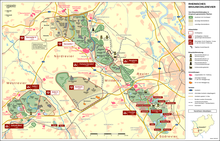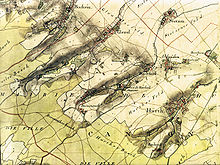Aldenrath
Aldenrath were a hamlet and a castle in the area of today's town of Hürth , which were destroyed by the brown coal mining. Ecclesiastically and politically, they belonged to the Gleuel district .
history
Aldenrath, also known as Aldenrode like the associated knight family in old sources, was probably settled in the second Franconian clearing period. Remains of a Roman aqueduct , which recorded the sources of the seven leaps of the Gleueler Bach, and other finds from Roman times, such as the grave finds from the 3rd century, indicate that the area was already settled during the Roman Empire. In the following Frankish period, the Roman estates became crown estates of the Franconian kings. It is possible that the castle courtyards around Aldenrath also have such ancient roots.
A document from the year 898, with which Duke Zwentibold , King of Lorraine, donated possessions in Kierdorf and other lands to Essen Abbey as well as possessions in Gleuel and Sielsdorf , is the oldest document for the Hürth area. These goods came to the Margaretenkapelle in Cologne around 1150, whereby the cathedral monastery became the owner. These Fronhöfe were redistributed in the 13th century, whereby the Burghöfe Aldenrath, Bell, Horbell and Schallmauer became the property of the Cologne Dompropstei . At least now Aldenrath belongs to the group of goods that came into church property in 898.
Aldenrath, located about 500 meters southeast of the still existing Schallmauer Castle on the map from 1808 , has been beset by lignite mining since the 1930s and has been demolished. Before the land and buildings were sold to Roddergrube AG , the hamlet consisted of 12 houses with 73 inhabitants. Until it was demolished in 1936, Aldenrath owned a castle a little further up the valley and its farm buildings.
Berrenrath (Neu-Berrenrath) was resettled in its place . The village of Berrenrath also had to give way to lignite mining in 1952/53. The old Berrenrath was in the area of today's Otto-Maigler-See .
Aldenrath Castle
| Aldenrath Castle | ||
|---|---|---|
| Creation time : | 12th century | |
| Castle type : | Moated castle | |
| Conservation status: | Demolished in 1936 | |
| Construction: | Brick | |
| Place: | Berrenrath | |
| Geographical location | 50 ° 52 '49 " N , 6 ° 48' 39" E | |
|
|
||
The knight seat Aldenrath was a fiefdom of the Cologne cathedral provost.
The knight family von Aldenrode was mentioned several times in documents from 1296 (first mentioned in 1295; with knight Andreas de Aldenrode). In 1325 Gottfried von Aldenrode took over some of the lands from Stotzheim that were added to the Aldenrath estate. In 1521 it was transferred to Heinrich Wolff (called Metternich) in Frielsheim through marriage with the heiress of Aldenrath (Katharina). Since the marriage remained childless, the estate passed to Katharina's son from his first marriage, Adam von Wolff-Metternich.
In 1558, Adam von Wolff-Metternich's castle house was rebuilt and enlarged as a brick building with a moat. It was on a hilltop that was probably originally an early medieval moth . He married Elisabeth von Boenen and in 1573 bought a farm in Ursfeld with 24 acres of land. Their daughter married Freiherr von Flans and shared the estate with her brother-in-law, whereby she received the castle.
Her son Johann Adam von Flans received the castle in 1626 and married the heiress to Overbach near Jülich. In 1655, Wolter married Franz Graf von Geul, Baron von Hoensbroech, and became the new owner of the castle.
His son Philipp Wilhelm Konrad von Hoensbroech became the new owner of the castle in 1672, but sold it in 1683 to Johann von Draensdorf from the von Draensdorf family of councilors from Cologne, from whom it passed to Cornelius Joseph von Heinsberg by marriage in 1740.
In 1770 the eldest son of Cologne mayor Johann Heinrich Arnold von Mylius , Hermann Joseph von Mylius, became the new owner of the castle through inheritance and marriage. After his death and that of his wife Walburga Elisabeth, the sons Eugen and Karl Josef inherited the estate, which they managed together until Eugen von Mylius' death. Karl Josef Freiherr von Mylius was Prefect of the Lippe Department under Napoleon and from 1815 to 1819 the first Lord Mayor of Cologne after French rule. In 1836 he had the gable roofs of the castle house demolished and replaced with new ones, as the old roofs were too heavy for the castle walls. The helm roof of the tower was also torn off and replaced by a clover-leaf arch frieze with a crenellated wreath .
His widow Walburga von Gehr divided the estate among their children, whereby Aldenrath came to the Aachen Ober-Procurator Eberhard von Mylius . He had the courtyard buildings rebuilt and the estate enlarged by buying 50 acres of cleared forest.
Since Eberhard von Mylius was unmarried, the estate returned to his mother after his death. After her death in 1882, it came to her three daughters by will.
Ultimately, the castle was sold to the industry, who leased the estate and had the castle itself converted for residential purposes. In 1936 it had to give way to lignite mining and was demolished.
The last appearance of the castle
In the end, the castle had the appearance of two square castle buildings of different sizes, which were arranged at right angles to each other. In the re-entrant corner between the two buildings was the tower used as a staircase, as well as an external staircase to the portal entrance.
Both buildings had a basement and three more floors, the tower had another. The castle had large rectangular windows that were not evenly spaced and were slightly offset on the smaller castle building. In various places of the larger building on the side facing the ditch it was visible that individual windows had been bricked up. A lavatory had been built there. A few small windows had also been walled up on the smaller building and it had a tent roof .
At the corner of the two buildings was the stair tower, which changed from the square base up to an octagon .
The buildings also had a partially above ground cellar.
The farm buildings in the outer bailey and completely separated from the castle were arranged in a "U" shape and date from the 19th century.
The castle buildings, which were situated on an elevation, were surrounded by a wall, which was supported by buttresses and had rounded corner bastions . It was also protected by the castle pond.
Consequences of the demolition of the castle
Due to the demolition of the castle, the Cologne district lost the chance to conduct an investigation of the early castle history and the castle complex (Motte). Due to the almost square floor plan, there are also parallels to the historically important castle houses of the Bergheim district. An investigation of the castle prior to its demolition was not carried out for unknown reasons.
In 1952, three, probably even four, Roman graves were found in the immediate vicinity of the Aldenrath hamlet, consisting of a sarcophagus, two cremation burials and a burial that is not secured. Other, destroyed graves were probably in the vicinity of the castle complex.
Lignite finds and mining
Mining concession for the Mylius pit
In the spring of 1818, lignite was found on a field belonging to Gut Aldenrath. The Aldenrath landlord Karl Josef Freiherr von Mylius, who was Lord Mayor of Cologne at the time, applied to the Prussian administration for a mining concession . On November 16, 1818, the "Myliusgrube" was the first Rhenish lignite fair that was awarded. Several hundred tons of lignite were mined within a few years and the operation was then inactive for 140 years before the Mylius pit was finally emptied by the “Gotteshülfe” pit.
Impossibility of revoking the license
The concession for the Myliusgrube is still in the land register of the mines. It is no longer possible to cancel this by hearing all heirs, of whom there are estimated to be over 300, as many have emigrated or gone missing. In the mining land register, the right of the Myliusgrube is a "legal flying Dutchman" for all eternity.
Water sources
The water source Sieben Quellen , better known as Sieben Sprünge , located about 150 m above Aldenrath Castle , belonged to the source area of the Gleueler Bach.
During the excavation work by the mining industry, parts of wooden gutters and Roman water pipes made of stone were found. The pipes, which were partly on top of each other, formed a drainage system to feed the water into a pipe.
literature
- Paul Clemen : The art monuments of the Rhine province . fourth volume. L. Schwann, 1897. (Reprint: 1983, ISBN 3-590-32118-0 )
- Clemens Klug: Hürth - how it was, how it was. Heimatverein Hürth (ed.). Steimel Verlag, 1961/1962.
- Robert Wilhelm Rosellen: History of the parishes of the deanery Brühl. In: Karl Theodor Dumont (Ed.): Parishes of the Archdiocese of Cologne. JP Bachem publisher, 1887.
- Home register of the community of Hürth. Beyer & Schmeitzer, Cologne 1934.
- Marlies Breuer-Trost: Landscape change in the southern lignite mining area in the course of open-cast mining and recultivation; Mixed agricultural and forestry recultivation under the aspect of the recreational landscape using the examples of Kippe Berrenrath and United Ville open-cast mine near Knapsack. In: Heimat und Kulturverein Hürth (Hrsg.): Hürther Heimat. 31 + 32/1973.
Web links
- Entry by Hans-Jürgen Greggersen on Aldenrath in the scientific database " EBIDAT " of the European Castle Institute
Individual evidence
- ↑ a b c d Clemens Klug: Hürth - how it was, how it was. Pp. 60/61.
- ↑ a b c d e f g h i Robert Wilhelm Rosellen: History of the parishes of the deanery Brühl. P. 293ff.
- ↑ Raymund Gottschalk: Studies on late Roman grave finds in the southern Lower Rhine Bay Diss. Bonn 2003 online at DNB (search for "Aldenrath" required)
- ↑ a b c Home directory of the municipality of Hürth. P. 64.
- ↑ Hürth home. 12 + 13/1966 Print of the certificate from the photo archive in Marburg; P. 2.
- ↑ Translation of the certificate at archive.nrw.de
- ^ A b c d e Frank Kretzschmar: Erftkreis cultural region - losses of a monument landscape. ISBN 3-7927-1228-8 , pp. 58/59.
- ↑ Marlies Breuer-Trost in Hürth home. 31 + 32/1973, p. 49ff, p. 53ff.
- ↑ a b c d e Paul Clemen: The art monuments of the Rhine province. Pp. 138/139.
- ↑ a b c J. Köllen, H. Kisky, R. Steimel: Seal and coat of arms, castles and palaces in the district of Cologne. 1966, p. 78.
- ↑ a b Fritz Wündisch: from Klütten and Briquettes. Pp. 51, 52.
- ↑ after Gottschalk s. O.
- ^ Fritz Wündisch: from Klütten and Briquettes. P. 51.
- ↑ Waldemar Haberey: The line C from the valley of Gleuel, p. 17/18 . In: The Roman water pipes to Cologne . 1971, ISBN 3-7927-0146-4 (source version of the Gleueler line at Aldenrath Castle).
Remarks
- ↑ Due to the different spellings of names, the name may be given differently in different sources, although it is obviously the same person. So z. B. under Wündlich the name of the first Lord Mayor of Cologne Karl Josef Freiherr von Mylius as Carl v. Mylius stated. According to Rosellen, the first names of the same person with Karl Joseph are given with "ph" at the end and without Freiherr.





